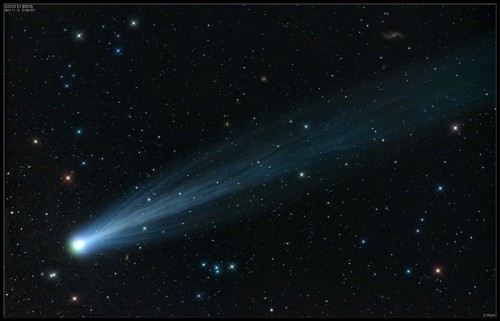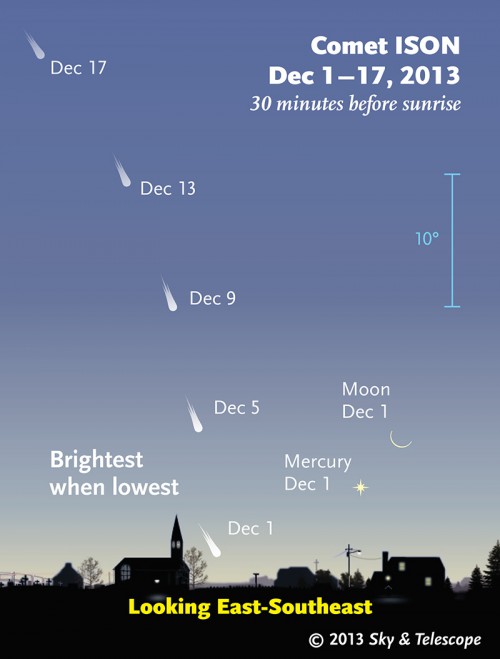VIDEO: Comet ISON moves ever closer to the Sun in this movie from the ESA/NASA Solar and Heliospheric Observatory, captured in the early hours of Nov. 27, 2013. A coronal mass ejection explodes off the Sun; it is unlikely to damage ISON even if they cross paths. Image Credit/Caption: ESA/NASA/SOHO
The moment of truth is approaching fast for Comet ISON (officially identified as comet C/2012 S1) as it continues its suicidal plunge toward the Sun at an incredible velocity of over 200 miles per second. Now, after falling toward the Sun from the depths of the outer Solar System over millions of years, ISON is less than 24 hours from passing within less than 1 million miles of the Sun’s surface on Thanksgiving Day.
At its closest approach, known as perihelion, ISON will graze the Sun at 720,000 miles above its surface. Astronomers and scientists from around the world have been watching closely because, being that ISON has never visited the Sun, the pristine matter from the earliest days of the Solar System’s formation still coats the comet’s surface. ISON’s visit is unique because no “first time visitor” has entered the inner Solar System at any point in recorded history, which presents a rare research opportunity for researchers to take advantage of the knowledge hidden in this time capsule from when the Solar System first formed. Those secrets about the formation of the Solar System that are hidden within the comet are expected to explode into space (literally) as the comet heats up and slingshots around the Sun on Nov. 28.

An unprecedented number of spacecraft (16 in all), as well as astronauts aboard the International Space Station and astronomers around the world, are working together to observe the comet as it passes through our neighborhood. The comet is now close enough to our star for NASA’s solar observing spacecraft to detect it, and the astronomy community around the world will be monitoring ISON closely as it swings around the Sun while enduring incredibly violent gravitational forces and hellish temperatures.
“Comet ISON is a dynamically new sungrazing comet, fresh in from the Oort Cloud, and the last time we saw an object like this was never,” said astronomer Karl Battams of NASA’s Comet ISON Observing Campaign. “Furthermore, a sungrazing comet just days from perihelion has never been studied in this kind of detail – we’re breaking new ground! When we factor in your standard ‘comets are unpredictable’ disclaimer, what we have is a huge recipe for the unknown.”
Over the last week the astronomy community has speculated that the comet is disintegrating as it approaches the Sun, due to explosions in its brightness and activity. Images from NASA’s Solar and Heliospheric Observatory (SOHO) and STEREO-A spacecraft, however, show ISON in tact as it races toward the Sun at 240,000 mph.

“I will admit that I was pretty worried yesterday morning when reports of lower production rates came in,” says Matthew Knight of the Lowell Observatory and NASA’s Comet ISON Observation Campaign. “However, the STEREO-A brightness has increased steadily over the subsequent 36 hr, and I’m more optimistic again. My off-the-cuff thought is that there was an [outburst of dust, which dampened the emission lines] from roughly Nov 20-22, and it has returned to brightening again.”
There has been much speculation since ISON’s discovery in 2012 that it could become one of the most fantastic comets any of us will see in our lifetimes—or it could fizzle into nothing and be no more “spectacular” than comet Pan-STARRS was this past spring (barely visible to the naked eye, if at all). If ISON survives its suicidal solar encounter, it could put on a spectacular show in our night skies over the holiday season, assuming it can withstand the 5,000+ degree temperatures and incredible gravitational forces it will encounter. The comet, however, poses no threat to Earth, as its closest approach to our world happens Dec. 26 at a distance of about 40 million miles.
“We really do not know what comet ISON is going to do when it gets near the Sun. Its passage through the solar corona is going to expose it to some really pretty insane solar radiation bombardment that will begin to furiously boil its surface away,” wrote Battams on the ISON Observing Campaign website. “In addition to that, the gravitational tug of the Sun will pull and stretch the comet, testing its structural integrity to the absolute maximum. Either, or both, of these factors could lead to its demise at any point in the days surrounding perihelion.”
If ISON survives its hellish encounter with the Sun this Thursday, then amateur astronomers should again be able to view the comet beginning this weekend, as ISON pushes back out into the Solar System. Nobody knows if ISON will survive or not, and if it does nobody knows just how visible the comet may become. The general public, in a best case scenario, might be able to see ISON before sunrise as soon as next week with the naked eye. However, if the Sun destroys ISON, then nobody will see anything. Or, the Sun could pull ISON apart, breaking it into smaller fragments which might make for an unforgettable sight in December.
Everyone—scientists and the public alike—will have to wait together to see what ISON does. You can view and tune into expert commentary from Battams and others as ISON swings around the Sun online tomorrow at this Google+ hangout from 1 p.m. EST to 3:30 p.m. EST.
Want to keep up-to-date with all things space? Be sure to “Like” AmericaSpace on Facebook and follow us on Twitter: @AmericaSpace



